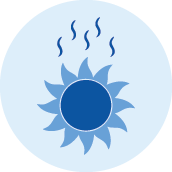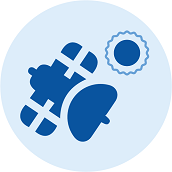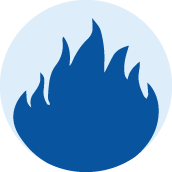WildfiresNgā ahi taikaha
In New Zealand, people cause 98% of wildfires. They can happen any time of year, so your actions make all the difference. Find out what to do before, during and after wildfires.
On this page
About wildfires
You don’t need to live in a rural area to be at risk from wildfire. If there’s vegetation close by and potential for someone to generate a spark, then there’s a wildfire risk.
Don’t wait until there’s smoke in the air to prepare. Help protect your property from wildfire.
Visit checkitsalright.nz to find practical steps you can take to reduce the risk of wildfire.
Protect your property from wildfire
- Keep your grass short and green, if possible, around buildings on your property.
- Keep gutters and areas around decks clear of dead leaves, debris and pine needles.
- Remove highly flammable plants close to buildings on your property. This includes avoiding bark mulch or similar ground coverings.
- Plant low flammability plants.
- If you have a RAPID number, make sure it is visible at your property entrance. Your accessway must be wide enough for a fire engine (4m wide by 4m high).

Learn how to protect your home from outdoor fires on Fire and Emergency’s website.

The flammability of vegetation affects fire intensity. This has a major influence on fire control and the chance of homes being damaged or destroyed by fire. Find out what plants have low or high flammability on the Fire and Emergency New Zealand website.
Get ready before a wildfire
Always check whether it’s safe to light a fire and if you’ll need a fire permit at checkitsalright.nz.
Practice good fire safety when doing anything that could cause a spark.
Plan your escape route. When planning your route, you won’t always know what direction the fire is coming from. It’s important to have more than one way out.
Identify a safe zone that is clear of vegetation in case you can’t evacuate and have to shelter in place. You may need to shelter in place on your property or in your community. A safe zone might be somewhere that has:
- large areas of concrete,
- well-maintained short grass, or
- large volumes of water.
Work out what supplies you might need and make a plan with your whānau. Make sure you include your animals in your plan.
Know how you will stay informed. Emergency services will always try to alert you to an approaching wildfire. But there may not be time to issue an official warning. Be aware of what is happening in your area.
Particularly if you see or smell smoke on a hot or windy day, because fire can move very quickly.

Make a plan online with your whānau to get through an emergency. Think about the things you need every day and work out what you would do if you didn't have them.

In an emergency, you may be stuck at home for three days or more. Your house is already full of emergency items disguised as everyday things. Figure out what supplies you need and make a plan to get through.

Your animals are your responsibility. You need to include them in your emergency planning and preparation.
What to do during a wildfire
If in doubt, get out!
Wildfires move quickly. If you can see smoke or flames from a wildfire and you feel unsafe, don’t wait for an official warning to leave. Evacuate immediately. Call 111 if your life or property is threatened, or you can’t evacuate on your own.
If you have time before you evacuate:
- turn on sprinklers,
- fill gutters with water, and
- wet down materials like firewood that may fuel the fire.
If there is time, you can also:
- move vehicles to a safe location;
- move lightweight outdoor items inside;
- wet down the sides of buildings, decks and plants close to your home;
- move animals and livestock to a well-grazed or ploughed area;
- close windows, doors and vents, and shut blinds; and
- seal gaps under doors and windows with wet towels.
Stay informed. Listen to the radio or follow your Civil Defence Emergency Management Group online.
Do not fly drones around the fire. Drones affect firefighting air operations.

Find your local Civil Defence Emergency Management (CDEM) Group.
What to do after a wildfire
Only return home if you are told it is safe to do so. Watch out for firefighters still working in the area.
Some roads may still be closed because of:
- ongoing firefighting operations,
- fallen trees and branches,
- downed powerlines, or
- damage to roading infrastructure.
Stay informed because the situation can change quickly and get worse again. Listen to the radio or follow your Civil Defence Emergency Management Group online.
Watch out for burnt trees, hot embers on the ground and fallen powerlines.
Treat all damaged trees as dangerous. Don’t walk under them until an arborist has assessed them.
Treat any fallen powerlines as live until the power authority has confirmed otherwise.
Cleaning up after a wildfire
Get professional advice about ventilating and cleaning if your home or belongings smell of smoke. It’s not uncommon after a wildfire for the smell of smoke or a smoky haze to remain for several days.
When cleaning up, wear:
- enclosed footwear,
- eye protection,
- gloves,
- a face mask, and
- long trousers.
Contact your local council’s environmental health officer for advice before using:
- food collected from the property,
- onsite feed supplies for animals, or
- water from storage tanks for drinking.
Boiling water does not remove fire retardants or other chemicals from your water.
Types of hazards | Ngā momo matepā
In New Zealand we have a lot of natural hazards. Find out what to do before, during and after each type of emergency.









